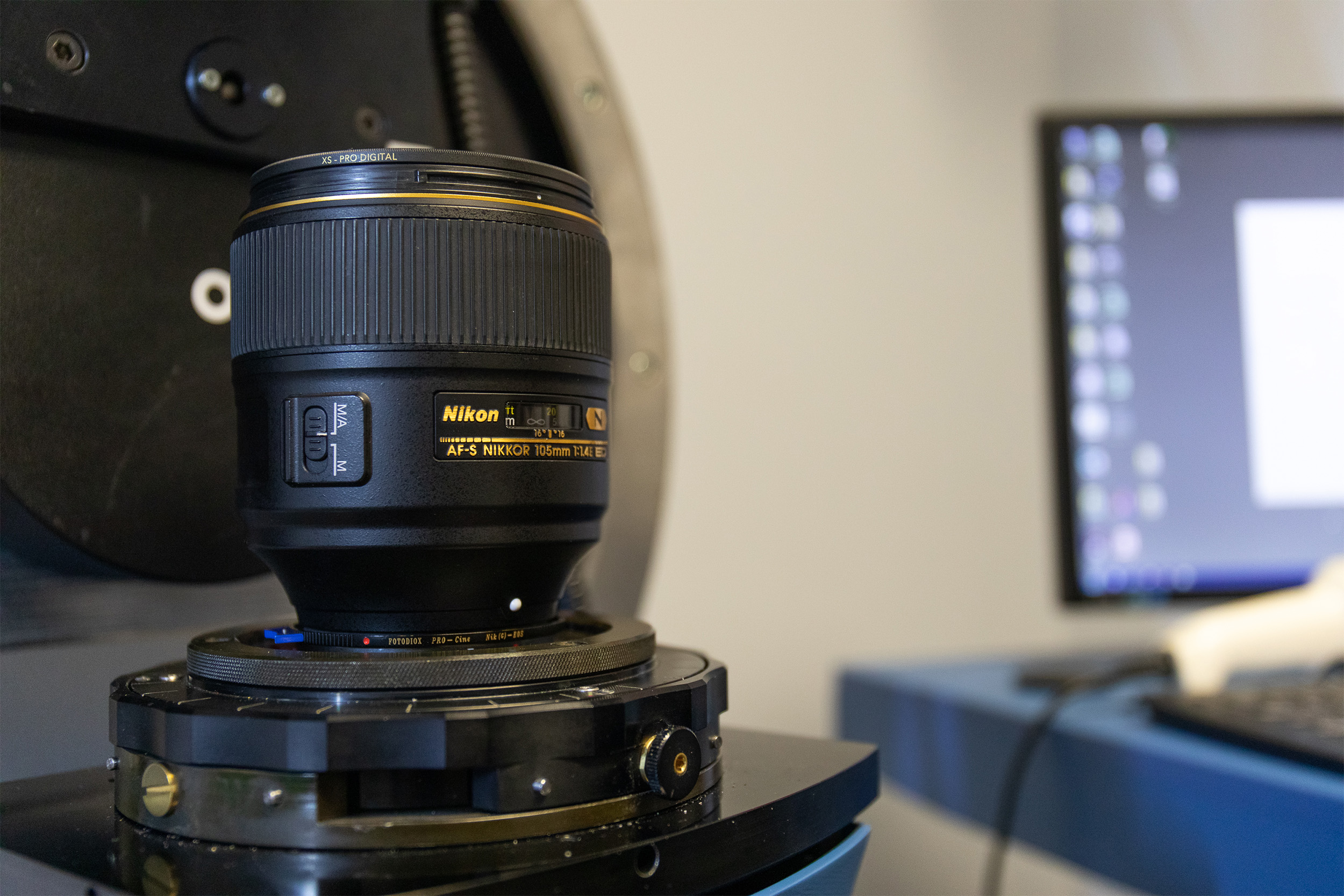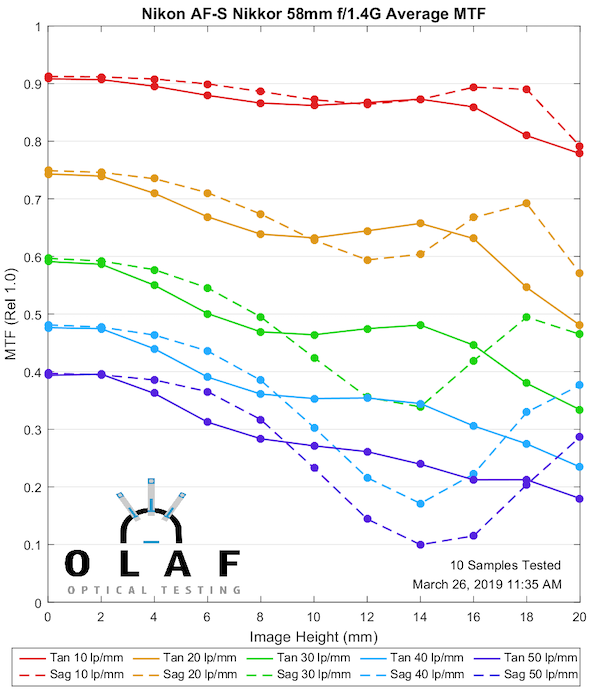Just MTF Charts
Just MTF Charts: Nikon Prime Lenses

We’ll continue our just MTF chart series of posts with the Nikon brand prime lenses. For those of you who have been asking, The Digital Picture is going to add all our MTF graphs to their comparison tool as we release them. That will let you do logical comparisons like ‘is the Sony 135mm f/1.8 GM sharper at the edges than the Sigma 14mm f/1.8‘ to prove your brand is the absolute best in online forum wars.
Three quick answers to questions that I’m sure will be asked:
- Z lenses testing requires sacrificing a camera and lens for electronics, machining a new mount for the bench, and wiring everything together. It’s a long and expensive process and we won’t have Z-lens test results for at least months.
- No, we don’t test stopped down. Lensrentals is willing to pay the cost for 10-copy tests wide open to establish standards for QA testing (which is always done wide open) and we share them. If you really want stop-down results, a 10 lens series costs $5,500. Email me and I’ll tell you where to send your check.
- The 24mm f1.8 isn’t missing because I forgot. I didn’t have enough results to post a 10-copy average.
A Quick How to on Reading MTF ChartsIf you’re new here, you’ll see we have a scientific methodology to our approach, and use MTF charts to measure lens resolution and sharpness. All of our MTF charts test ten of the same lenses, and then we average out the results. MTF (or (or Modulation Transfer Function) Charts measure the optical potential of a lens by plotting the contrast and resolution of the lens from the center to the outer corners of the frame. An MTF chart has two axis, the y-axis (vertical) and the x-axis (horizontal). The y-axis (vertical) measures how accurately the lens reproduces the object (sharpness), where 1.0 would be the theoretical “perfect lens”. The x-axis (horizontal) measures the distance from the center of a lens to the edges (measured in millimeters where 0mm represents the center, and 20mm represents the corner point). Generally, a lens has the greatest theoretical sharpness in the center, with the sharpness being reduced in the corners. Tangential & Sagittal LinesThe graph then plots two sets of five different ranges. These sets are broken down into Tangential lines (solid lines on our graphs) and Sagittal (dotted lines on our graphs). Sagittal lines are a pattern where the lines are oriented parallel to a line through the center of the image. Tangential (or Meridonial) lines are tested where the lines are aligned perpendicular to a line through the center of the image. From there, the Sagittal and Tangential tests are done in 5 sets, started at 10 lines per millimeter (lp/mm), all the way up to 50 lines per millimeter (lp/mm). To put this in layman’s terms, the higher lp/mm measure how well the lens resolves fine detail. So, higher MTF is better than lower, and less separation of the sagittal and tangential lines are better than a lot of separation. Please keep in mind this is a simple introduction to MTF charts, for a more scientific explanation, feel free to read this article. |
Nikon MTF Charts
Nikkor 20mm f/1.8G ED

Lensrentals.com, 2019
Nikkor 24mm f1.4 G ED

Lensrentals.com, 2019
Nikkor 28mm f1.8G

Lensrentals.com, 2019
Nikkor 28mm f1.4E ED (by special request)
We didn’t put this in originally because I didn’t have 10 copies to test. Here’s the results for 5 copies, it’s all I could get to.

Lensrentals.com, 2019
Nikkor 35mm f1.4G

Lensrentals.com, 2019
Nikkor 35mm f1.8G ED

Lensrentals.com, 2019
Nikkor 50mm f1.4G

Lensrentals.com, 2019
Nikkor 50mm f1.8G

Lensrentals.com, 2019
Nikkor 58mm f1.4G

Lensrentals.com, 2019
Nikkor 85mm f1.4G

Lensrentals.com, 2019
Nikkor 85mm f1.8G

Lensrentals.com, 2019
Nikkor 105mm f1.4E ED

Lensrentals.com, 2019
Nikkor 105mm f2.8G IF-ED VR Micro

Lensrentals.com, 2019
For a look at all the Just MTF Articles we’ve done so far, be sure to check them out here.
Roger Cicala, Aaron Closz, and Brandon Dube
Lensrentals.com
April, 2019
Addendum: The Digital Picture is hosting the MTF charts on their comparison tool, putting them up as we publish them here. It’s a great way to compare two lenses for the one or two of you who like to do that. The Canon and Zeiss primes are already up, the Sigma should be added by tomorrow.
Author: Roger Cicala
I’m Roger and I am the founder of Lensrentals.com. Hailed as one of the optic nerds here, I enjoy shooting collimated light through 30X microscope objectives in my spare time. When I do take real pictures I like using something different: a Medium format, or Pentax K1, or a Sony RX1R.
-
Duckie
-
Steven D. Keirstead
-
Naveen Kailas
-
Ayoh
-
Roger Cicala
-
Ayoh
-
Ayoh
-
Roger Cicala
-
Ayoh
-
Marcello Mura
-
Patrick Cligny
-
Lance Blackburn
-
Matti6950 .
-
Andre Yew
-
Chris in NH
-
Mattr
-
Roger Cicala
-
Rokoko
-
bdbender4
-
Ernest Green
-
P. Jasinski
-
Roger Cicala
-
Brandon Dube
-
Brandon Dube
-
Andreas Werle

